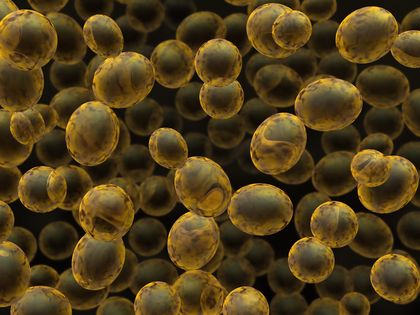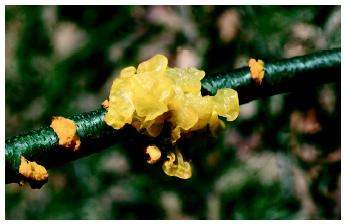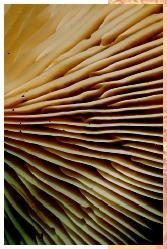Fungi

Fungi are eukaryotic organisms distinct from plants and animals and members of several other smaller kingdoms. Common fungi include mushrooms, conks, corals, jellies, puffballs, stinkhorns, morels, cups, truffles, lichens, yeasts, rusts, smuts, bread molds, mildews, and molds on bathroom tiles.
In 1959, R. H. Whittaker introduced a five-kingdom taxonomy that granted fungi equal status with plants and animals. The five-kingdom system has been supplanted by a multiple-kingdom classification, and species traditionally treated as fungi are now distributed across several kingdoms. Those believed to form a monophyletic lineage are assigned to kingdom Eumycota (often called kingdom Fungi). Mycology, the science devoted to fungi, still covers all traditional fungi.
Characteristics of Fungi
The Eumycota consist of eukaryotic, nonchlorophyllous heterotrophs that absorb nutrients from dead or living organic matter, have cell walls composed of chitin , and store excess energy as glycogen . The kingdom contains four phyla: Chytridiomycota, Zygomycota, Ascomycota, and Basidiomycota. All true fungi have a definite cell wall throughout all developmental stages. Fungal cell walls are composed of chitin, the compound also found in arthropod exoskeletons (for example, lobster shells). Most fungi produce a vegetative mycelium (filamentous thallus) composed of hyphae that branch and extend via tip elongation, although some groups (like yeasts) consist only of individual cells. Hyphae (singular, hypha) are tube-like filaments with either single multinucleate cells (coenocytes) that lack septa (cross-walls) separating nuclei, or many septate cells containing one, two, or more nuclei.
Fungal Nutrition: Saprobes, Parasites, and Mutualists
A fungal thallus may be as small as a single microscopic cell (baker's yeast, Saccharomyces cerevesiae ) or exceedingly large ( Armillaria gallica, the several-acre-sized "humungous fungus" reported in 1992 as the world's largest organism). Sporocarp (fruit body, or "mushroom" size) also ranges from microscopic to meters in diameter ( Bridgeoporus nobilissimus, an endangered bracket fungus found on noble fir trees).
Not unexpectedly, such a diverse kingdom manifests several different life cycles. Virtually all fungi produce spores. Both asexual and sexual spores may germinate to form vegetative thalli from primary and secondary mycelia. Thalli may be haploid dominant, diploid dominant, or exhibit haplo-diploid alternation of generations. Here it is important not to confuse the chromosomal state of individual nuclei (haploid versus diploid) with the number of nuclei per cell (monokartyotic versus dikaryotic). Fungi are unusual in that they often exhibit dikaryotamy, wherein hyphal cells contain two (usually haploid) nuclei that migrate, multiply, and divide together.
Although superficially similar to plants, fungi are probably more closely related to animals. Like animals, fungi lack chlorophyll and do not photo-synthesize, must obtain nutrients from organic sources, and store energy as glycogen instead of starch. Unlike animals, however, fungi do not engulf, but rather absorb, their nutrients after breaking them down via enzymatic action, earning them the nickname "absorbotrophs."
Fungi absorb their nutrients in three different ways: (1) saprobes decompose dead organic matter; (2) parasites feed on living hosts; and (3) mutualists live in symbiotic unions with other living organisms. Saprophytic fungi, such as edible meadow mushrooms ( Agaricus campestris ), shiitake ( Lentinula edodes ), and oyster mushrooms ( Pleurotus ostreatus ), decompose dead plant and animal tissue by releasing enzymes from hyphal tips, thereby recycling organic materials back into the surrounding environment. Parasitic fungi also use enzymes to break down living tissue, usually sapping the energy of the host and frequently causing its demise.
Lichens and mycorrhizae are two important mutualistic associations. Lichens represent partnerships between a fungus (mycobiont) and one or more algae (phycobiont). Although there are a few basidiolichens, almost all

Ecological and Economic Importance
Fungi have a profound biological and economic impact. As decomposers, plant pathogens, and symbiotic partners, their ability to grow anywhere, on anything, makes them both beneficial and harmful recyclers of carbon and nitrogen. Beneficially, they are used as food (mushrooms, truffles) and in baking and brewing (yeasts). They are being developed to detoxify pollutants (soil fungi), control insects (pathogenic Zygomycota), and regulate plant growth (pathogenic Ascomycota). Detrimentally, rusts, smuts, and molds cost billions of dollars through crop disease and spoilage while forest pathogens such as the honey mushroom ( Armillaria ostoyae ) and root-butt rot ( Heterobasidion annosum ) similarly threaten the timber industry. Some are toxic when eaten, such as the infamous destroying angel ( Amanita phalloides ). Natural LSD, a hallucinogen produced by ergot ( Claviceps purpurea ), is associated with medieval hysterical frenzies produced by consumption of infected grain, and the aflatoxin produced by Aspergillus flavus in improperly stored grain is one of the most potent carcinogens yet discovered. As human and animal pathogens, fungi cause infections that range from the vexing (athlete's foot, yeast infections) to life threatening (histoplasmosis). Fortunately, other fungi (such as Penicillium ) have been used to develop modern antibiotics and beneficial immunosuppressants .
Classification
With the introduction of deoxyribonucleic acid (DNA) sequence analyses, previous fungal evolutionary theory is undergoing rapid transformation, not surprising when one considers the extremely fragmentary fungal fossil record. Mycologists generally agree that true fungi (with animals and plants) diverged from the protozoan fungi (for example, slime molds and Oomycota) before fungi and animals diverged from plants. The chytrids separated from the remaining phyla approximately 550 million years ago, followed by splintering of the Zygomycota from the other two phyla, which share septate hyphae and dikaryotic stages in their life cycles. The Ascomycota split from the Basidiomycota approximately 400 million years ago, followed by an increase in fungal diversity throughout the Paleozoic. Most yeasts and "asco-molds" are thought to have evolved in approximately the last 200 million years.
While most plants and vertebrates appear to have been described, most fungi have yet to be discovered or named. The 1995 edition of the Dictionary of Fungi counts 566,360 described species (about 100,000 in the Eumycota) but notes that there may be approximately 1.5 million species of fungi in the world. Elias Fries (1794–1878), often regarded as the "father of mycology," classified fungi based primarily on spore print color and sporocarp appearance. Friesian-based nomenclature, reflecting similarity of form (phenetic) rather than genetic relationships, is still used in many field guides. Now, however, taxonomists are integrating molecular and morphological characters to develop natural classifications that more adequately reflect evolutionary relationships. Realizing that fungal taxonomy and nomenclature will remain somewhat fluid until new species and data are analyzed and integrated, most mycologists generally accept the classification below.
Chytridiomycota. The fact that chytrids alone among the Eumycota produce motile zoospores explains why their phylum is sometimes assigned with the flagellate oomycetes to kingdom Chromista. Chytrids possess posteriorly uniflagellate spores, mitochondria with flattened cristae, and cell walls composed of glucan and chitin. Among the simplest and smallest fungi, they live as saprobes in water and damp organic-rich habitats, or as parasites on invertebrates, plants, and other fungi. The so-called "frog chytrids" ( such as Batrachochytrium dendrobatidis ) are implicated in the current worldwide decline of amphibian species. Other chytrids are host-specific "rumen fungi" ( such as Piromyces communis ) that thrive in anaerobic conditions in the guts of herbivores, such as cattle and sheep. There are five orders and about 800 species of chytrids recognized thus far.
Unicellular members of the order Chytridiales lack a mycelial stage and consist of a central body with a few rudimentary appendages (haustoria) that attach to and invade the host tissue. Other chytrids, such as the Blastocladiales, develop true mycelia with sporangia and male/female gametangia that produce uniflagellate zoospores. Chytrid thalli may be either haploid or diploid, and some, like the aquatic chytrid Allomyces, exhibit an isomorphic alternation of generations with similar appearing sexual and asexual zoospores.
Zygomycota. The chytrids and this phylum are assigned the two "bottom" branches of the fungal evolutionary tree. There are more than 1,000 species in two classes (Trichomycetes, Zygomycetes) and ten orders, representing a diverse assemblage of saprobes, soil fungi, obligate insect and fungal parasites, and mycorrhizal formers. Common representatives of the saprobic order Mucorales include the dung-inhabiting "cap-thrower" ( Pilobolus ), the black bread mold ( Rhizopus stolonifera ), and Phycomyces blakesleeanus, sometimes referred to as the "body in the basement" because of the rapid growth of long, hairlike sporangiophores over a substrate under the right conditions.
Zygomycota are characterized by large, thick-walled, coenocytic zygospores and hyphae with relatively thin walls composed of chitin and chitosan. Both asexual sporangiospores and sexual zygospores germinate into haploid mycelia, with the hyphae functioning as gametangia during the sexual stage. In Rhizopus, for instance, close proximity of two hyphal strands of different mating types chemically triggers each to grow branches toward the other to form septate suspensor cells and gametangia. Eventual fusion produces a diploid zygosporangium that undergoes meiosis to become a thick-walled zygospore with large numbers of haploid nuclei.
Ascomycota. In addition to most lichens and so-called "imperfect fungi," about 33,000 species of unicellular yeasts, green and black molds, powdery mildews, morels, cup fungi, and ascotruffles ("true" truffles) belong to this phylum. The phylum is characterized by ascospores produced within a saclike sporangium called an ascus. Mycelia (more complex than Zygomycota mycelia) are composed of septate hyphae with chitin-glucan hyphal walls. Most species produce specialized fruiting bodies called ascocarps whose details of structure help define different species, classes, or orders. Nonascocarpic representatives (such as unicellular yeasts and mildews that reproduce primarily by budding) do not form mycelia. Both sexual and asexual reproduction are found within this phylum.
Basidiomycota. This phylum, which also features septate hyphae and chitin-glucan cell walls, is characterized by basidiospores borne upon a club-like structure called a basidium. Approximately 22,500 species are assigned to three classes: Basidiomycetes, Teliomycetes, and Ustomycetes. Basidiomycetes include mushrooms, polypores, crusts, corals, clubs, basidiolichens, and jellies, which propel their spores, and "gastromycetes" (or "stomach fungi") that passively release their spores (puffballs, basidiotruffles ["false truffles"], stinkhorns, and birds' nests). Teliomycetes (rusts) and Ustomycetes (smuts) are obligate parasites of insects or plants. Rusts and smuts have exceedingly complex cycles involving up to five separate spore stages and multiple hosts. This ability to produce spores on different hosts in multiple ways presents a significant economic challenge to agriculture.
Oomycota. Oomycetes (kingdom Chromista) are distinguished from true fungi by having glucan-cellulose cell walls that only occasionally incorporate small amounts of chitin. These algae-like fungi occur in aquatic or moist terrestrial habitats as single cells or mycelial mats composed of multinucleate, nonseptate hyphae. Their life cycle generally mirrors that of plants, with a transitory haploid stage. Both resting oospores and motile zoospores are diploid, the latter propelled by two unequal flagella (tinsel type plus whiplash). This phylum contains about 700 species in nine orders, including

SEE ALSO Alternation of Generations ; Kingdom ; Mycorrhizae ; Plant Pathogens and Pests ; Symbiosis
Lorelei L. Norvell
Bibliography
Alexopoulos, C. J., C. W. Mims, and M. Blackwell. Introductory Mycology, 4th ed. New York: John Wiley & Sons, 1996.
Arora, D. Mushrooms Demystified: A Comprehensive Guide to the Fleshy Fungi. Berkeley, CA: Ten Speed Press, 1986.
Hanlin, R.T., and M. Ulloa. Atlas of Introductory Mycology, 2nd ed. Winston-Salem, MA: Hunter Textbooks Inc., 1978.
The infection with these fungi caused reduction in the seed germination ratio to 28% and 16 % in the seed of the local cultivar and the red (Dwarf) with F.oxysporum respectively . while seeds of white cultivor (Doppio) exhibited ratios of 60% and 80% with both species of Fusarium.
The biological controller Trichoderma herzianum had a clear effect on the growth of both species of the Fusarium and the antagonism degree 1.3 and 1.6 respectively.
Fusarium oxysporum producd more polygalacturonase , pectatelyase and showed a clear zone 6 cm diameter around the fungal colony.
It really helped me to
learn more about fungi.